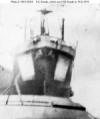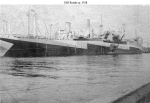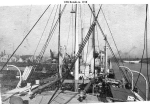| Click on thumbnail for full size image |
Size | Image Description | Source | |
|---|---|---|---|---|
 |
55k | In port, possibly when inspected by the Third Naval District on 25 March 1918 U.S. Navy photo NH 103035 |
Naval Historical Center | |
 |
97k | Ships at the Norfolk Navy Yard, Portsmouth, Virginia circa October 1918. They are (from left to right): USS Paul Jones (Destroyer No. 10); USS Katrina Luckenbach (ID 3020); and Rondo. All are painted in pattern camouflage Collection of Arthur J. Rozett U.S. Navy photo NH 102950 |
||
 |
121k | Ships at the Norfolk Navy Yard, Portsmouth, Virginia circa October 1918. They are (from left to right): USS Paul Jones (Destroyer No. 10); USS Katrina Luckenbach (ID 3020); and Rondo. All three are wearing pattern camouflage. A steam launch from USS Indiana (Battleship No. 1) is in the center foreground. U.S. Navy Divers Float No. 2 is in the left foreground. All are painted in pattern camouflage Collection of Arthur J. Rozett U.S. Navy photo NH 102950 |
||
 |
135k | Rondo possibly shown at the Norfolk Navy Yard, Portsmouth, Virginia, in late 1918 outboard of USS Katrina Luckenbach (ID 3020). Note that the two ships are moored bow to stern instead of bow to bow and that the starboard side pattern camouflage of Rondo is visible Collection of John Lynch Naval History and Heritage Command photo from Shipscribe.com |
Robert Hurst | |
 |
157k | Rondo taken ca. late 1918 from her aft gun platform Collection of John Lynch Naval History and Heritage Command photo from Shipscribe.com |
||
Departing New York 12 April 1918, Rondo steamed to Norfolk to load Army supplies for U.S. forces in Europe. Rondo subsequently made two round-trip convoy voyages across the Atlantic between 7 May and 5 September 1918, unloading cargo at La Pallice, Verdon, and Bordeaux, France.
Rondo was fitted for service as a horse transport during September 1918 under U.S. Shipping Board account. As an animal transport, she made one voyage to Montevideo, Uruguay, arriving 16 February 1919. Returning northward to Boston to unload her cargo, Rondo was later assigned duty carrying food to Europe. After engine trouble once forced her back into port, Rondo reached Falmouth, England, 28 May 1919. Steaming on to Amsterdam, Rondo was decommissioned and returned to her owner 21 June 1919. Rondo remained in Nederland Stoomvaart Maatsehappij service until scrapped during 1933.
| Back to the Main Photo Index | Back to the Identification Numbered Vessel (ID) Photo Index |
| Comments, Suggestions, E-mail Webmaster |
|
This page created by Joseph M. Radigan and maintained by David Wright |